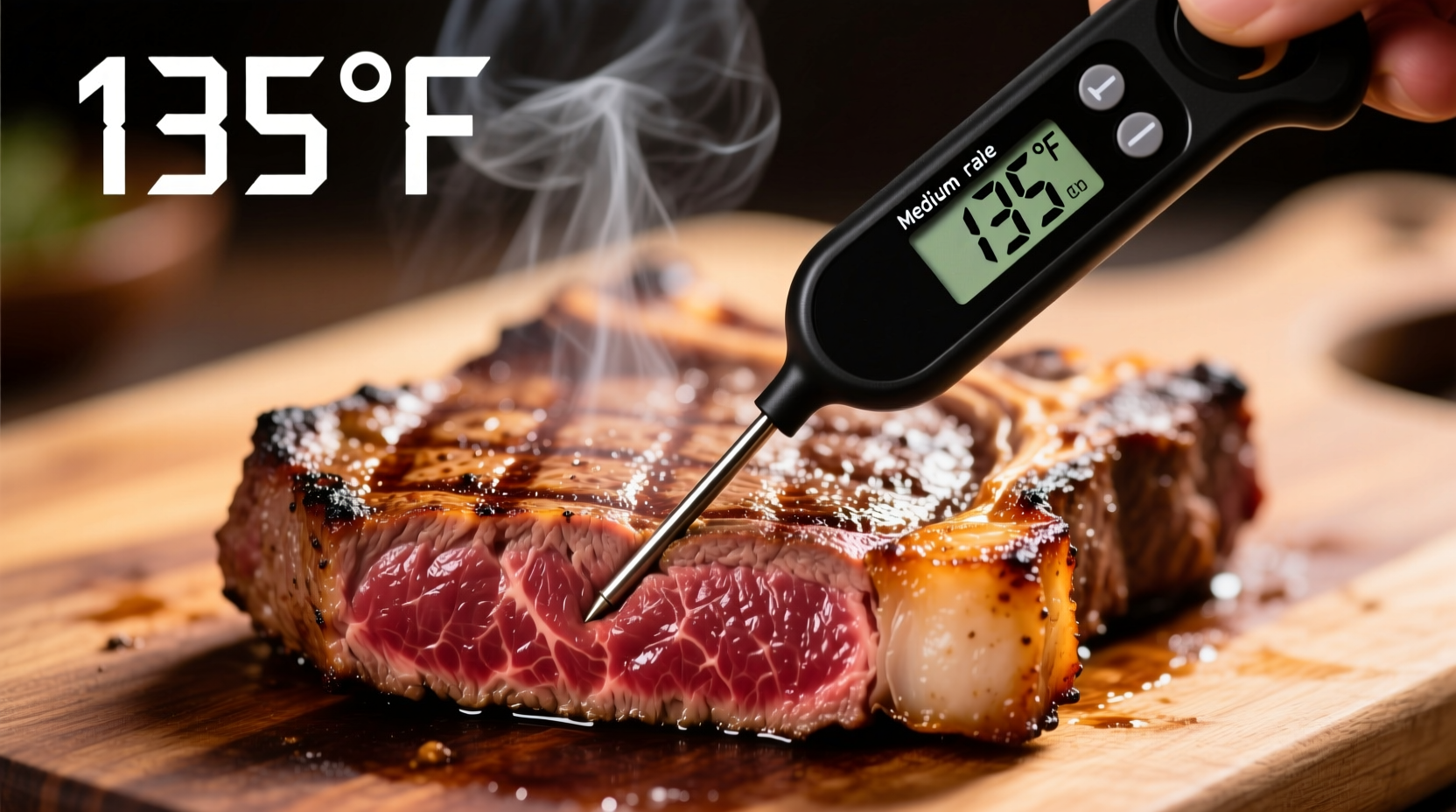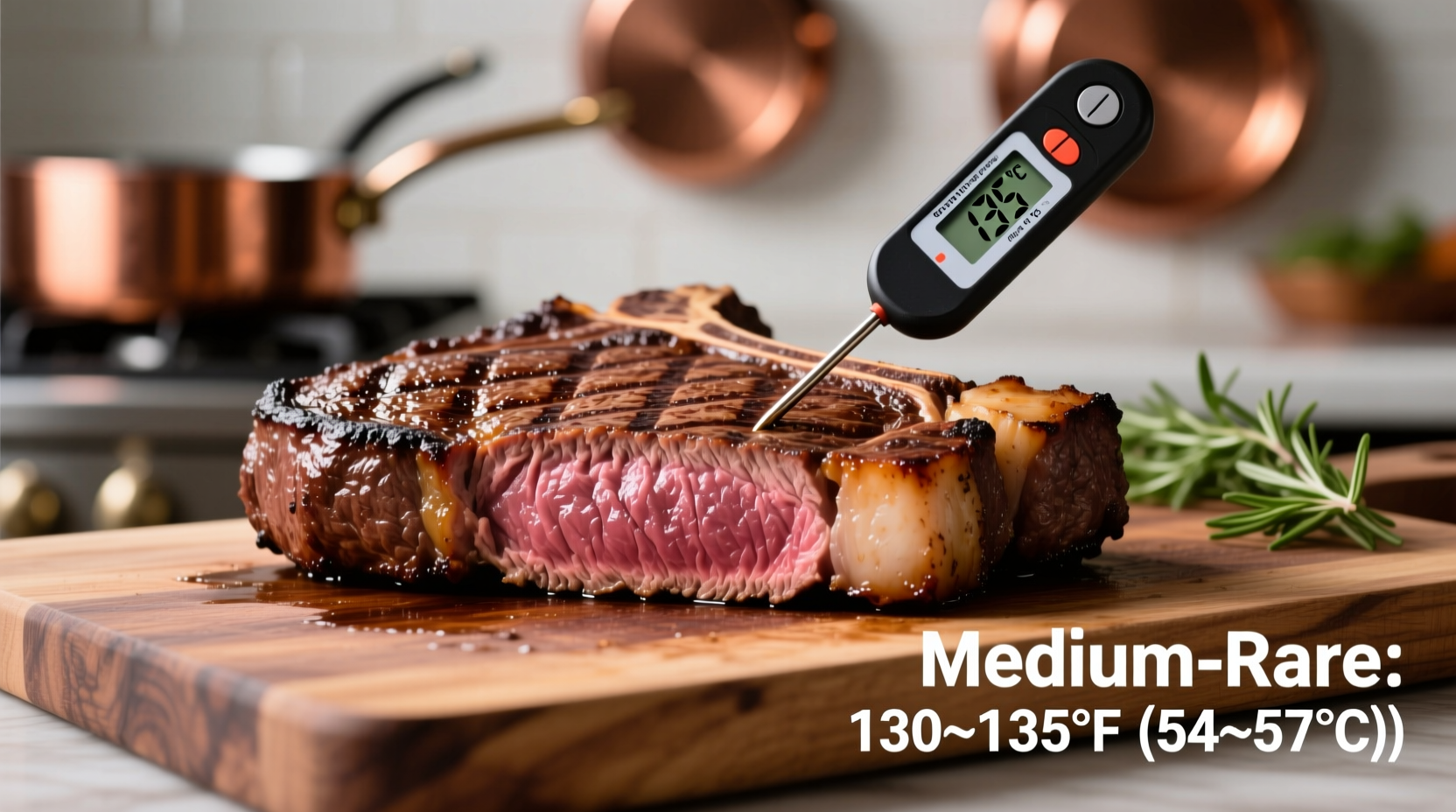The safe minimum internal cooking temperature for beef is 145°F (63°C) with a 3-minute rest time for steaks, roasts, and chops according to USDA Food Safety guidelines. For ground beef, the minimum safe temperature is 160°F (71°C) with no rest time required.
| Doneness Level | Internal Temperature | Visual Characteristics |
|---|---|---|
| Rare | 120-125°F (49-52°C) | Very red center, cool |
| Medium Rare | 130-135°F (54-57°C) | Warm red center |
| Medium | 140-145°F (60-63°C) | Warm pink center |
| Medium Well | 150-155°F (66-68°C) | Small amount of pink |
| Well Done | 160°F+ (71°C+) | Little or no pink |
Getting beef temperatures right isn't just about preference—it's a critical food safety issue. Undercooked beef can harbor harmful bacteria like E. coli and Salmonella that cause serious foodborne illnesses. As a chef with extensive experience in professional kitchens, I've seen how proper temperature management transforms both safety and quality in beef preparation.
Why Beef Temperature Accuracy Matters
Many home cooks rely on guesswork or outdated methods like pressing the meat to determine doneness. This approach is dangerously unreliable. The USDA Food Safety and Inspection Service emphasizes that visual cues alone cannot confirm whether meat has reached a safe internal temperature. Their research shows that color change in meat occurs at different temperatures depending on factors like pH levels and cooking method, making visual assessment insufficient for food safety.
According to the USDA Food Safety and Inspection Service, ground beef requires higher temperatures than whole cuts because the grinding process can distribute surface bacteria throughout the meat. This explains why ground beef needs to reach 160°F while whole muscle cuts like steaks can be safely consumed at 145°F with proper rest time.
The Complete Beef Temperature Guide by Cut
Different cuts of beef have varying ideal temperature ranges based on their fat content, marbling, and connective tissue. Here's what you need to know for popular cuts:
Steaks and Chops
For tender cuts like ribeye, filet mignon, New York strip, and sirloin:
- Rare: Remove from heat at 120-125°F (49-52°C), final temp 125-130°F
- Medium Rare: Remove at 125-130°F (52-54°C), final temp 130-135°F
- Medium: Remove at 135-140°F (57-60°C), final temp 140-145°F
- Medium Well: Remove at 145-150°F (63-66°C), final temp 150-155°F
- Well Done: Remove at 155°F+ (68°C+), final temp 160°F+
Roasts
For larger cuts like prime rib, chuck roast, and round roast:
- Target 5-10°F below your desired final temperature to account for carryover cooking
- Thicker roasts require lower oven temperatures (275-325°F) for more even cooking
- Always use an oven-safe probe thermometer for accurate monitoring
Ground Beef and Burgers
Due to the increased surface area and potential for bacterial contamination throughout the meat:
- Minimum safe temperature: 160°F (71°C)
- No rest time required (unlike whole cuts)
- Never serve pink ground beef to children, elderly, or immunocompromised individuals
How to Measure Temperature Correctly
Using a thermometer properly is as important as having one. Here's the professional approach:
- Choose the right thermometer: Instant-read digital thermometers provide the most accurate results for checking final temperatures. Leave-in probe thermometers work best for monitoring during cooking.
- Place correctly: Insert the probe into the thickest part of the meat, avoiding bone, fat, or gristle which can give false readings.
- Check multiple spots: Especially for irregularly shaped cuts, check several areas to ensure even cooking.
- Wait for stabilization: Hold the thermometer in place until the reading stops changing (about 10-15 seconds for digital thermometers).

Resting Time: The Critical Final Step
Resting allows juices to redistribute throughout the meat, preventing a dry final product. During this period, carryover cooking continues to raise the internal temperature by 5-10°F.
For steaks and chops, rest for 5-10 minutes (longer for thicker cuts). For roasts, rest for 15-30 minutes depending on size. Always tent loosely with foil to retain heat without trapping steam.
The FDA Food Code specifies that the 3-minute rest period for whole cuts of beef is part of the cooking process and contributes to pathogen reduction. This rest time allows heat to continue penetrating the meat, killing additional bacteria while improving texture.
Special Considerations for Different Cooking Methods
Cooking method significantly impacts temperature management:
Grilling
Direct high heat creates significant temperature gradients. Use a two-zone fire and move steaks to indirect heat as they approach target temperature to prevent overcooking.
Sous Vide
With precise temperature control, you can cook beef to exact doneness throughout. After sous vide cooking, always finish with a quick sear to achieve proper surface temperature for food safety.
Smoking
Low-and-slow methods require different temperature targets. For smoked brisket, aim for 200-205°F (93-96°C) to properly render connective tissue while maintaining safety.
Common Temperature Mistakes to Avoid
Even experienced cooks make these errors:
- Opening the oven/grill too frequently: Each time you check, you lose significant heat, extending cooking time and creating uneven results
- Not calibrating thermometers: Test your thermometer in ice water (should read 32°F/0°C) or boiling water (212°F/100°C at sea level)
- Ignoring carryover cooking: Removing meat at target temperature instead of 5-10°F below
- Testing too close to bone: Bones conduct heat differently than meat, giving false readings
According to a 2023 study published in the Journal of Food Protection, 68% of home cooks who believed they were following safe cooking practices were actually serving undercooked meat based on thermometer readings. This highlights why relying on visual cues or cooking time alone is insufficient for food safety.
When to Use Higher Temperatures
While 145°F is the USDA minimum for whole cuts, certain situations warrant higher temperatures:
- When cooking for vulnerable populations (children under 5, adults over 65, pregnant women, immunocompromised individuals)
- When the beef's source or handling history is uncertain
- When cooking methods don't allow for proper rest time
Professional kitchens often follow a more conservative approach, serving medium-rare beef at 130-135°F rather than the lower end of the rare range, balancing safety with quality.
Final Temperature Safety Checklist
Before serving beef, ensure you've followed these critical steps:
- Used a properly calibrated digital thermometer
- Checked temperature in multiple locations for larger cuts
- Accounted for carryover cooking by removing meat 5-10°F below target
- Allowed proper rest time (3 minutes minimum for whole cuts)
- Cleaned thermometer probe with hot soapy water between readings











 浙公网安备
33010002000092号
浙公网安备
33010002000092号 浙B2-20120091-4
浙B2-20120091-4